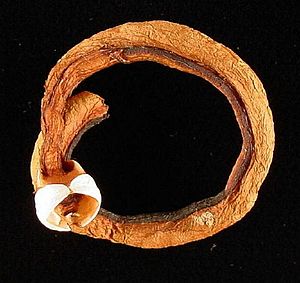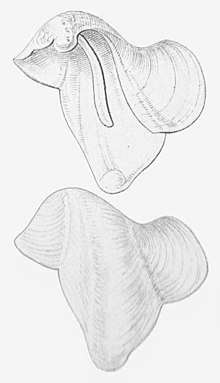Shipworm
| Shipworm | ||||||||||||
|---|---|---|---|---|---|---|---|---|---|---|---|---|

Shipworm ( Teredo navalis ) |
||||||||||||
| Systematics | ||||||||||||
|
||||||||||||
| Scientific name | ||||||||||||
| Teredo navalis | ||||||||||||
| Linnaeus , 1758 |
The shipworm ( Teredo navalis , also ship drilling mussel ) is, despite its name, not a worm , but a mussel - a species of the ship drilling mussel family (Teredinidae). Its body is greatly elongated and stretched like a worm. The very small housing (in relation to the length) only covers the foremost part of the soft body and is used for drilling in wood. The shipworm is relatively salinity tolerant (7 to 39 PSU ), and even survives short phases of freshwater cover unscathed by sealing its drill tube with the accessory calcareous plates (“pallets”). It can also withstand large temperature fluctuations (0 to 30 ° C).
Names
In addition to the prevailing terms Schiffsbohrwurm and Schiffsbohrmuschel the names and short forms are ship worm , Holzbohrwurm , Holzbohrmuschel , Pfahlbohrmuschel and pile worm used. The ambiguous name drill shell is also used.
features
The housing, which has the same flap, is by and large hemispherical. But it only covers the foremost part of the soft body. The elongated soft body, which is less than a centimeter in diameter, becomes up to 50 cm long, but usually remains smaller (20 to 30 cm). The case is only about an inch long and an inch high. In outline it is divided into three parts: a small, triangular front part, a large, tall, obliquely-shaped and distended middle part and a somewhat smaller, semicircular rear part (auriculum). The small, triangular front part starts at the top of the middle part, set off by a kink. The front part is provided with ribs running parallel to the edge, also somewhat curved, which are studded with prickly or thorn-like projections. The vertebra sits in the dorsal area of the front part of the housing. The middle part is usually only slightly ornamented with growth strips parallel to the edge, as is the rear part of the case. A narrow longitudinal pit runs from the vertebrae almost perpendicular to the longitudinal axis of the housing over the middle part of the housing to the ventral edge. The hemispherical auriculum (rear part of the housing) sits obliquely upwards on the middle part of the housing, but does not protrude beyond the vertebra. There is no ligament , lock teeth and accessory shell plates are also missing. The foot muscles sit on appendages: the rear, large sphincter begins in the auriculum, the anterior, small sphincter inserts in front of the vertebrae. The two valves are connected by two joint heads on the dorsal and ventral edges.
The aragonitic shell is white and consists of three layers: an outer prismatic, a central one with crossed lamellas and an inner layer made up of complex crossed lamellas. The periostracum is light brown.
In addition to the two-lobed shell of the shell at the front end, the mantle of the elongated body of the shipworm secretes a lime tube about 1 cm in diameter, which serves as a living tube for the shipworm; it is a lining of the bore hole created by the animal.
The soft body merges into two long, retractable siphons at the rear at the mouth of the borehole . They are used for breathing, for plankton to flow in as food and for the excretion of metabolic products, but also for the sperm cells to flow in and the larvae to flow out. At the base of the siphons are two lime plates (“pallets”), which consist of a leaf and a stem. The stem is oriented towards the borehole. If the siphons are withdrawn into the borehole, the two plates close the borehole opening like a cone.

The pallets are up to 6 mm long, of which two thirds of the length are on the leaf and one third on the stem. The width is also about a third of the (total) length. The sheet is slightly curved, with the concave side towards the siphon. This side is also referred to as the inside and the curved side as the outside. The upper edge is drawn out to points on the outside. However, the front edge is mostly uncalcified and consists of organic periostracum, so that specimens with a worn edge or if the organic periostracum is decomposed after the animal has died, the lateral tips are almost missing.
Geographical distribution and habitat
The shipworm lives in warm to temperate zones worldwide. The original distribution area can no longer be reconstructed, as the species has been transported around the world by the earlier shipping traffic with wooden ships. It lives in shallow to shallowest waters wherever suitable wood can be found in the water: in the walls of wooden ships, in wooden bridges, docks and jetties, wooden groynes and dolphins , as well as in driftwood and tree trunks lying in the water.
Way of life
The shipworm is characterized by its comparatively high tolerance to salinity and temperature. It can withstand brackish water down to a salt content of about 7 ‰ (older works call it 9 ‰) and temperatures down to freezing point (0 ° C). After a long, inconspicuous period since 1993, it has reached several mass occurrences along the German Baltic Sea coast. In the meantime, an adaptation to even lower salinity (the 7 ‰ mentioned) seems to have happened in the Baltic Sea, because the species has already been found in the eastern Baltic Sea.
After he has withdrawn the siphons at the rear of the body, the living tube can be closed to the water via two small spatula-shaped lime plates (“pallets”), so that the animal can survive several weeks of voyage in fresh water.
If the infestation is more severe, it can cause considerable damage to bridges , docks and jetties, dykes and wooden ships , provided they are in the open sea. The infestation of the wood by the shipworm can hardly be seen from the outside, as the opening to the water is comparatively small and the two small breathing siphons provide the only visible indication from the outside. The damage often only becomes apparent when it is canceled. Today the wood is impregnated to protect against the shipworm or provided with metal or plastic layers .

Reproduction and way of life
The shipworm is a protandric hermaphrodite that can change sex several times. When the animals become sexually mature after just 60 days, they are males first. After a few weeks and further increase in height and weight, the sex changes to the female. The shipworm can then produce 1 to 5 million eggs in a year. The eggs are retained in the gill area and fertilized there by foreign seeds that have rolled in. Apparently, semen from the male phase is also stored so that self-fertilization can also occur. The larva spends the first 14 days of development in the gill cavity. It is then ejected as a Veliger larva with a small D-shaped housing and swims freely in the water for one to three weeks. Then she attaches herself to a piece of wood with the help of a byssus thread , where she begins to drill with the help of the two shell flaps. The small, strongly gaping mussel shells serve this purpose only. Within about 60 days, the larva grows into an adult, sexually mature animal and continues to dig its way through the wood. Only the two small breathing siphons protrude from the opening to the water, which is only a few millimeters wide. It can be hermetically sealed with two special lime plates. The borehole is lined with a layer of lime and serves as a dwelling cave in which the shipworm spends the rest of its life. The shipworm can live two to three years.
The shipworm feeds itself by converting almost 80% of the cellulose components of the shredded wood into sugar with the enzymes cellulase and glucosidase . These enzymes are supplied by symbiotic bacteria in the gut. In addition, it filters plankton from the respiratory water as a nutritional supplement.
history
Damage from shipworms was already known to the ancient world. Initially, the hulls were equipped with additional planking as a kind of sacrificial wood. The Egyptians had given their ships a protective coat of paint, the Chinese built double-hulled boats with an intermediate layer of goatskin that resisted the access of the worms. The Romans tried to build sheet metal in the underwater area of their galleys , later they discovered the toxic effect of metal-containing ( tin , copper ) paints. The fact that the drillworms did not stop at the ships of Christopher Columbus' fleet can be seen from his logbooks , where he describes how his entire fleet of ships more or less fell apart under the feet of the crew for reasons that were still unknown at the time. Columbus lost a total of nine ships on his four voyages. In 1731, the shipworm in Holland had eaten the wooden dyke gates, whereupon they broke during a storm surge . From 1919 to 1921 he caused damage worth over 900 million US dollars to wooden quays in the San Francisco Bay .
Taxonomy
The species was described by Carl von Linné as early as 1758 . However, he still believed that the species was a worm. Teredo navalis is the type species of the genus Teredo Linnaeus, 1758.
literature
- Ruth D. Turner: A Survey and Illustrated Catalog of the Teredinidae . Harvard University, Cambridge 1966 ( biodiversitylibrary.org )
Individual evidence
- ↑ a b c d Luísa MS Borges, Lucas M. Merckelbach, Íris Sampaio, Simon M. Cragg: Diversity, environmental requirements, and biogeography of bivalve wood-borers (Teredinidae) in European coastal waters. In: Frontiers in Zoology , 2014, 11, 13, 13 pp.
- ↑ a b c Friedrich Schödler: Brehm's Illustrirtes Thierleben. Folk and school edition . Volume 3: Niedere Thiere. Verlag des Bibliographisches Institut, Hildburghausen 1872, p. 840 ( Google Books )
- ↑ a b c Drill mussels . In: Meyers Großes Konversations-Lexikon . 6th edition. Volume 3, Bibliographisches Institut, Leipzig / Vienna 1905, pp. 166–167 .
- ↑ a b The termites of the seas . Mirror online
- ↑ Shipworm gnaws at port facilities - the experiment is to show the density of infestation - millions of dollars in damage from Teredo navalis. In: Kieler Nachrichten , July 21, 2009; Retrieved July 10, 2017
- ↑ Development of a procedure to protect wooden structures in hydraulic engineering against the Teredo navalis pile drill. In: dbu.de. Retrieved April 21, 2017 .
- ↑ a b c d e Carsten Fiedler: Maritime wood destroyer - pile or shipworm (Teredo navalis). (last modified: October 6, 2016) accessed on July 10, 2017
- ↑ The drill shell destroys the Liège fishermen's pier . In: Flensburger Tageblatt , April 19, 2012; Retrieved July 10, 2017
- ↑ DEG Briggs, PR Crowther (eds): Palaeobiology II . Blackwell Science, Oxford 2007 (Chapter: Bioerosion, pp. 273-277).
- ↑ Kai Hoppe: The shipworm Teredo navalis . ( Memento of the original from September 8, 2005 in the Internet Archive ) Info: The archive link was inserted automatically and has not yet been checked. Please check the original and archive link according to the instructions and then remove this notice.
- ^ Carl von Linné: Systema naturae per regna tria naturae, secundum classes, ordines, genera, species, cum characteribus, differentiis, synonymis, locis. Tomus II. Editio decima, reformata. Pp. 1-824. Salvius, Holmia / Stockholm 1758, p. 651 ( biodiversitylibrary.org ).
- ↑ Teredinidae Rafinesque, 1815. MolluscaBase


